�
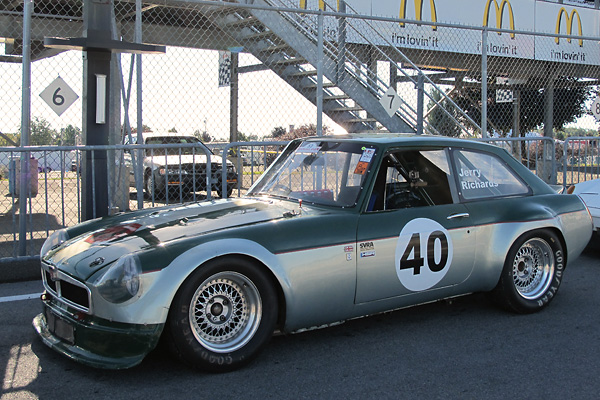
�
Jerry Richards' 1972 MGB GT V8 Vintage Race Car
� Owner: Jerry Richards� � City: Flowery Branch, GA
� Model: 1972 MG MGB GT V8
� Engine: Rover 3.5L V8
� Built by: owner�
�
Race Proven
��
This is the second of two MGB GT V8 racecars Jerry Richards has prepared and raced. Jerry purchased�
the first one in 1980 as a street car, whilst living at home in England. It was one of the rare�
"factory" V8s. Soon thereafter, Jerry decided to transform his MGB GT V8 into a Class D racecar�
under the regulations of the MG Car Club's BCV8 Championship program. He first raced his�
MGB GT V8 in 1986. (It appears here: Factory�
MGB GT V8 Racer Arrives.) Over subsequent racing seasons, Jerry has developed and improved�
his "Number 86" racecar in countless ways. �
�
In more recent years, Jerry decided to build a second MGB GT V8 racecar. Jerry's "Number 40"�
racecar (featured here) has carried him to victory in many races and in Sportscar Vintage�
Racing Association's 2010 Championship for Group 8 racecars.�
�
Jerry has decided to offer the Number 40 car for sale. With proceeds from the sale, he intends�
to build another racecar. Jerry keeps his cards close to his chest, but we predict it will�
be a different model car for an even faster racing class. Stay tuned.�
�
If you think you might be interested in purchasing this dialed-in and race-proven MGB GT V8�
vintage racecar, contact Jerry through this website:�
register,�
log in,�
view Jerry's profile, and�
then click on the words "Send a Private Message".�
�
The classified ad appears here: For Sale: Extremely Competitive MGB GT V8 Vintage Racecar�
�
 �
�
�
�
Features and Specifications
�| Engine: | �Rover 3.5L engine¹ built by Lee Hurley at HESCO in Birmingham Alabama.�
(Cast iron two-bolt main bearing caps.)�
Chevrolet-spec 6 inch H-beam connecting rods.�
~12.5:1 static compression ratio. �
Later model Rover cylinder heads, O-ringed.�
Rover valve covers.�
Four Weber 48DCO/SP carburetors, choked down to 38mm.�
John Eales swan neck intake manifolds.�
MSD Pro Billet Distributor distributor (part number 8548).�
MSD 6AL multiple spark discharge ignition controller.�
MSD Blaster 2 ignition coil.�
Moroso Blue Max spiral core 8mm spark plug wires.�
Oberg 600 screen type oil filter.�
Fram PH16 spin-on oil filter on a Mocal remote base.�
Stock Car Products 3-stage dry sump oil pump.�
Peterson engine oil reservoir.�
Mocal aluminum oil catch tank.�
Mocal 19-row oil cooler. | �
| Cooling: | �Griffin custom aluminum radiator. | �
| Exhaust: | �custom four-into-one headers built by Jerry Richards with help from Jay Bradley.�
32" long, 1.5"-to-1.625" step-up primaries.�
Speedway Motors collectors.�
Ceramic coated.�
2.25" exhaust pipes exit on right hand side.�
| �
| Transmission: | �close ratio Muncie M22 4-speed, prepared by Roper at Bremer Racing (Atlantic Beach, Florida.)�
D&D Fabrications aluminum bellhousing.�
D&D Fabrications aluminum flywheel.�
Ram Assault 2 plate clutch.�
Modified Hurst shifter. | �
| Rear Axle: | �General Motors 10-bolt rear axle.�
3.42:1 ring and pinion.�
Auburn limited slip differential. | �
| Front Susp.: | �7" long, 2.5" inside diameter, 750 lbs/in springs.�
(Lower spring pans have been flattened with a sledge hammer to suit smaller then stock diameter springs.�
Ride height has been adjusted by bolting shims into the upper spring perchs, and the �
shims have a step feature in them to help keep the springs centered.)�
Gutted Armstrong lever shock absorbers remain in place to serve as upper control arms.�
PRO-formance SHOCKS custom valved telescoping shock absorbers (5" long stroke).�
Fab-tek dropped spindles.�
7/8" anti-sway bar, on polyurethane mounts. | �
| Rear Susp.: | �five-leaf leafsprings.�
PRO-formance SHOCKS custom valved adjustable telescoping shock absorbers (7" long stroke).�
Custom anti-tramp bars and A-arm, all mounted below axle.�
FabTek adjustable anti-sway bar. | �
| Brakes: | �(master) dual Wilwood (3/4" and 7/16") master cylinders with adjustable bias bar.�
Wilwood remote reservoirs. Wilwood proportioning valve. � (front) Wilwood four piston aluminum calipers. Vented rotors. � (rear) Chevrolet drum brakes. | �
| Wheels/Tires: | �Compomotive 3-piece aluminum wheels (15x7.5).�
Goodyear Blue Streak tires (15x6.00). | �
| Electrical: | �compact Nippondenso alternator with large pulley.�
Lead-acid battery. | �
| Instruments: | �(left to right)�
Stewart Warner oil temperature gauge (140-325F),�
Stewart Warner water temperature gauge (100-265F),�
Elliot tachometer (0-8000rpm),�
Stewart Warner oil pressure gauge (5-100psi), and�
twin mini brake pressure gauges (0-1000psi). | �
| Fuel System: | �ATL 12 gallon aluminum cannister fuel cell.�
Holley electric fuel pump.�
Malpassi "Filter King" fuel pressure regulator. | �
| Safety Eqpmt: | �Willans six point cam-lock safety harness.�
Kirkey aluminum racing seat.�
Kidde dry chemical fire extenguisher. | �
| Weight: | �1980 pounds, plus 75 pounds of lead ballast to meet class rules. | �
| Comments: | �Jerry appreciates the support of his wife Mary and of frequent crew member Greg Scott,�
plus many other enthusiastic supporters over the years without whom he wouldn't�
have completed so many successful races. | �
Engine Installation
��
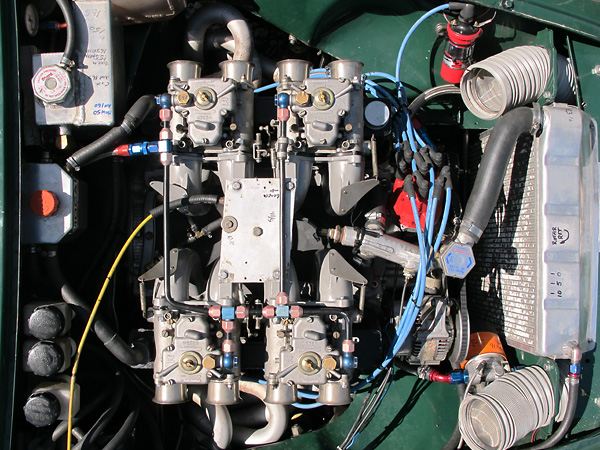
�
Rover 3.5L engine¹ built by Lee Hurley at HESCO in Birmingham Alabama.
�
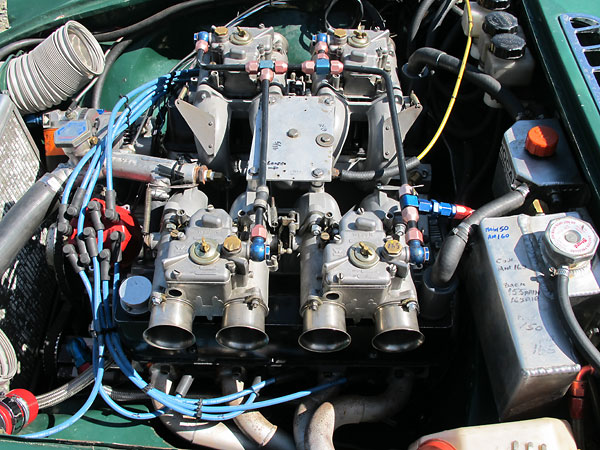
�
This engine was built with a static compression ratio of ~12.5:1.
�
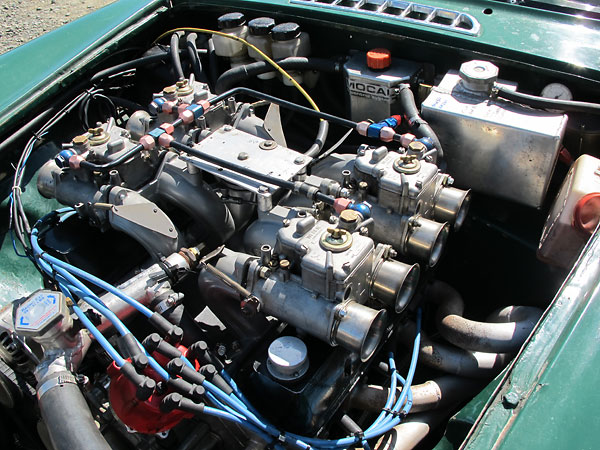
�
MSD Pro Billet Distributor distributor (part# 8548). Moroso Blue Max spiral core 8mm spark plug wires.
�
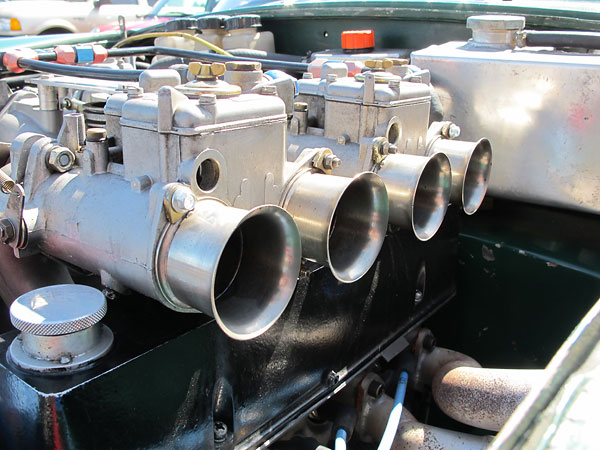
�
Ram tubes (a.k.a. velocity stacks or air horns) come in various lengths. Engine tuners select between
�
them to optimize performance for a specific RPM range. Weber 48DCO/SP ram tubes come in 16mm,
�
38mm and 75mm lengths. Jerry uses the 38mm version. Generally (but not always) longer ram tubes
�
shift the peak of an engine's torque curve to a lower engine speed.
�
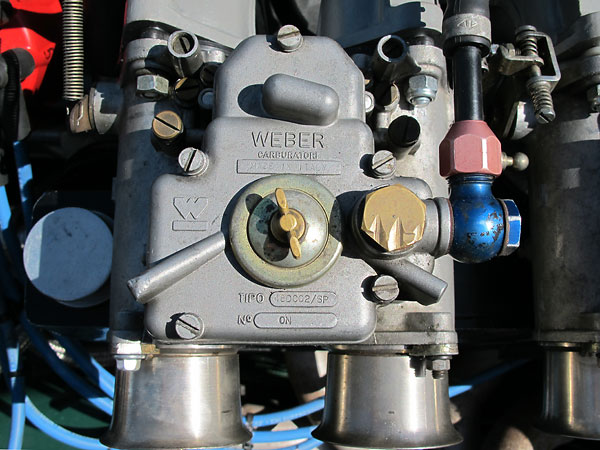
�
Weber Carburatori - Made in Italy - Tipo 48DCO2/SP - No ON
�
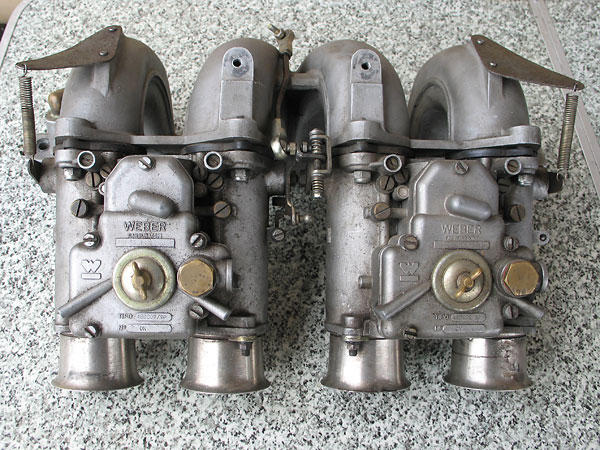
�
John Eales swan neck intake manifolds.
�
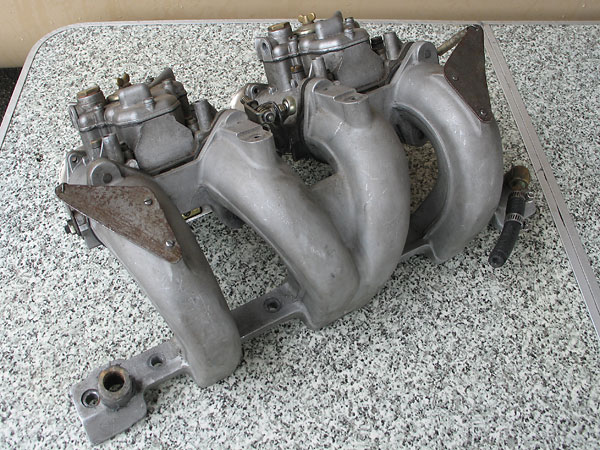
�
Throttle return spring brackets.
�
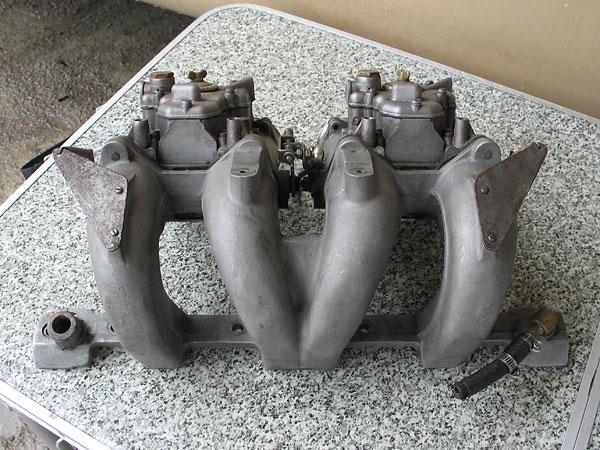
�
Back of the John Eales swan neck manifolds and Weber carburetors.
�
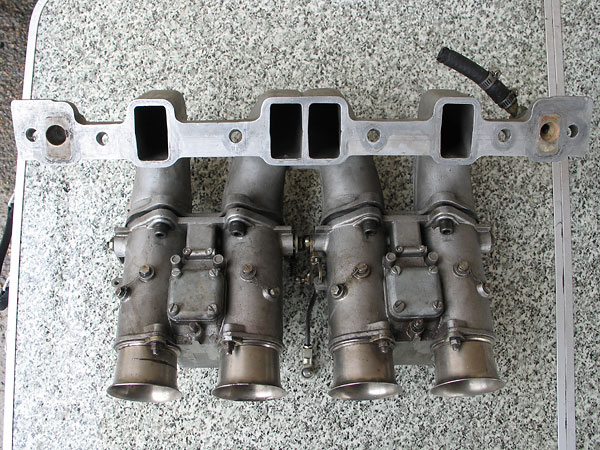
�
Bottom of the John Eales swan neck manifolds and Weber carburetors.
�
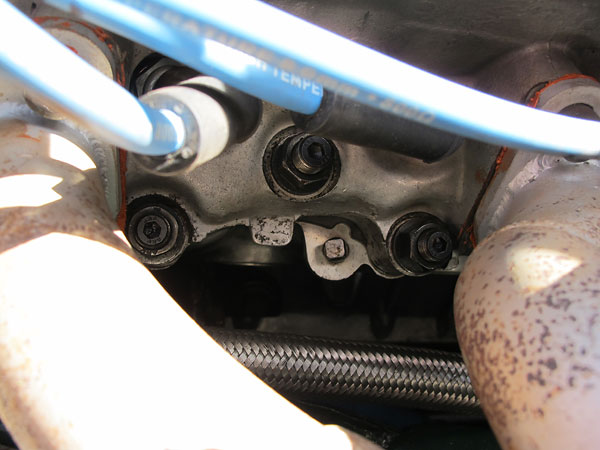
�
Dipstick hole plugged so the dry sump lubrication system can draw a vacuum inside the crankcase.
�
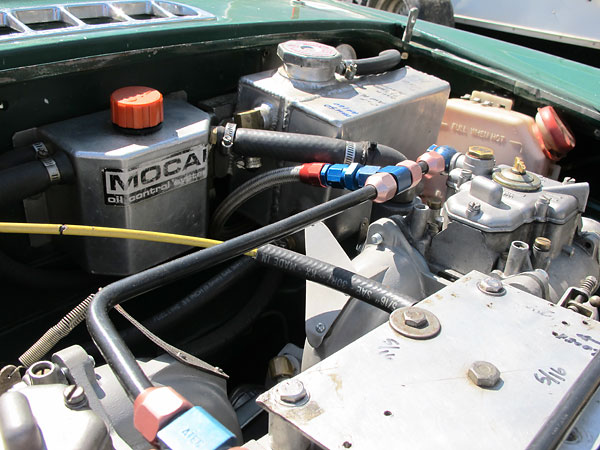
�
Mocal aluminum oil catch tank.
�
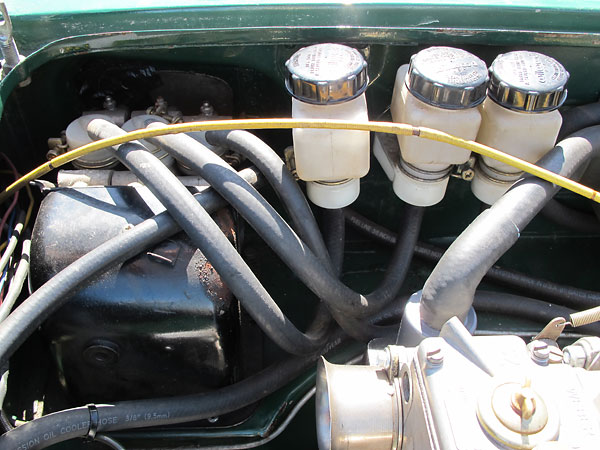
�
Dual Tilton master cylinders with adjustable bias bar and Wilwood remote reservoirs.
�
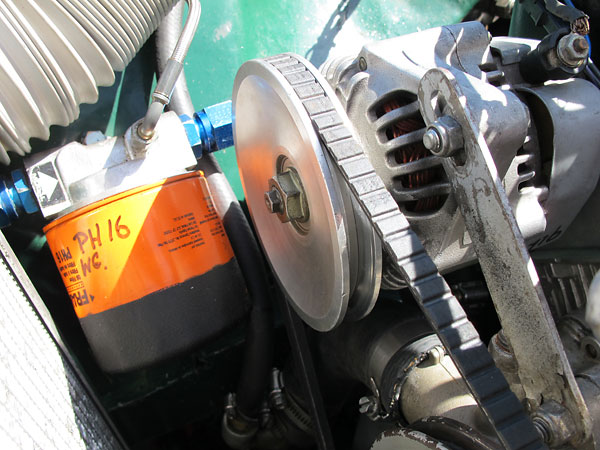
�
Fram PH16 spin-on oil filter on a Mocal remote base.
�
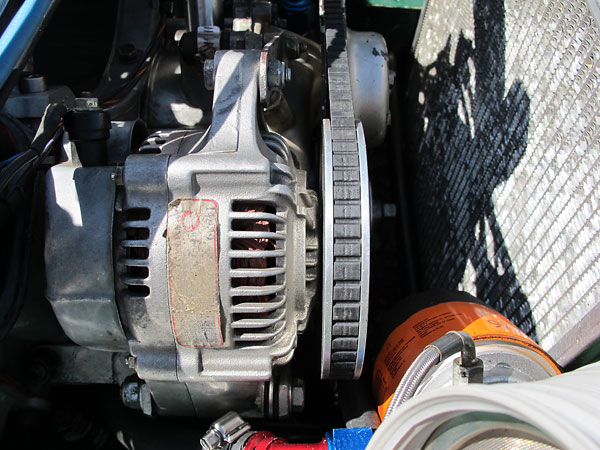
�
Compact Nippondenso alternator with large pulley.
�
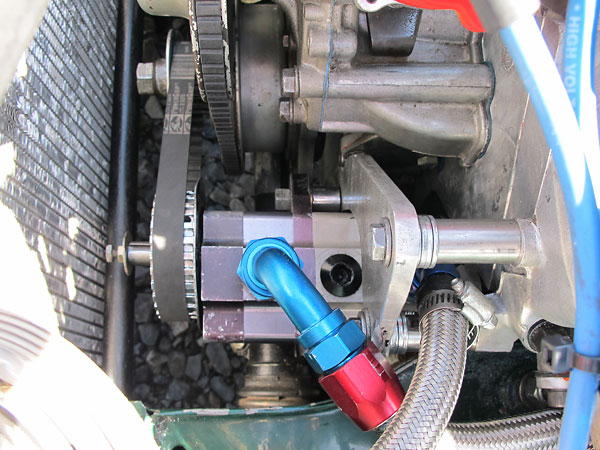
�
Stock Car Products 3-stage dry sump oil pump.
�
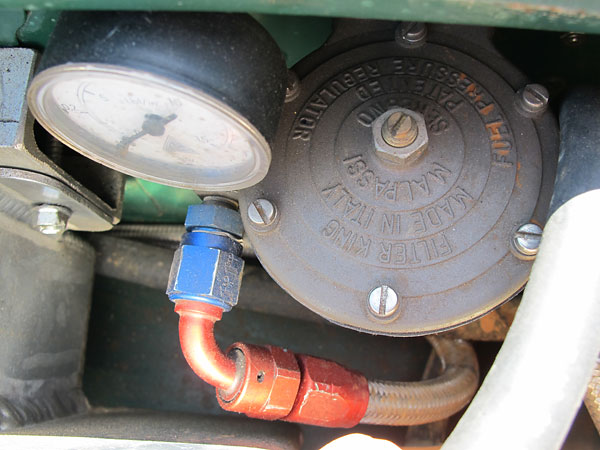
�
Malpassi Filter King fuel pressure regulator.
�
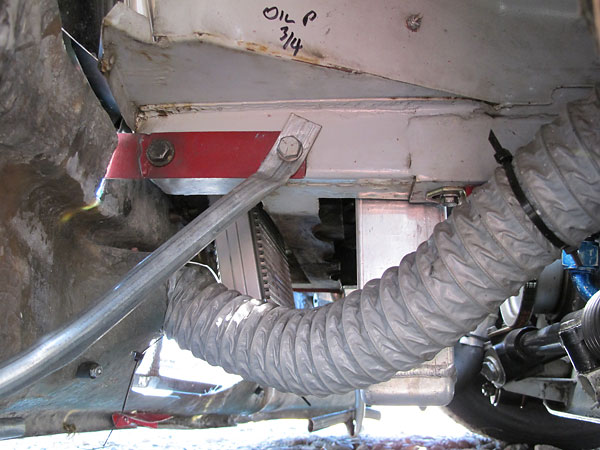
�
Left: Mocal 19-row oil cooler. Right: custom aluminum radiator by Griffin is 19" tall.
�
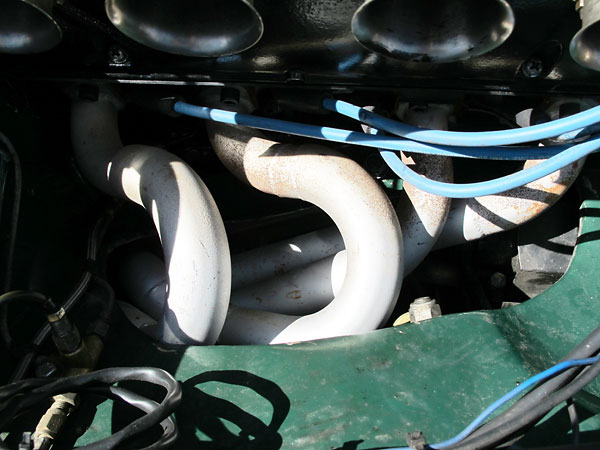
�
Custom four-into-one headers feature 32" long, 1.5"-to-1.625" step-up primaries.
�
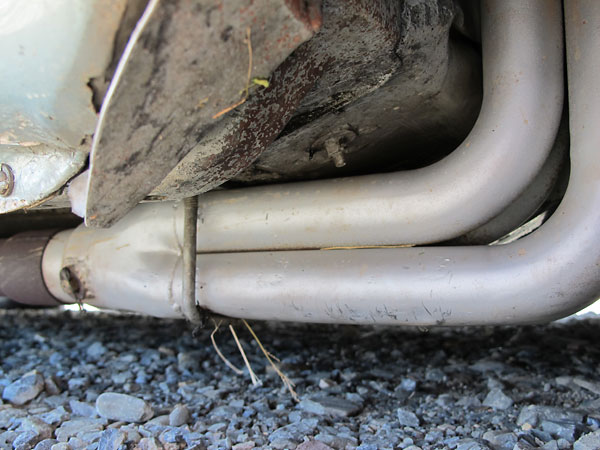
�
A bung has been welded onto this header collector for installation of an oxygen sensor.
�
�
Rear Suspension
��
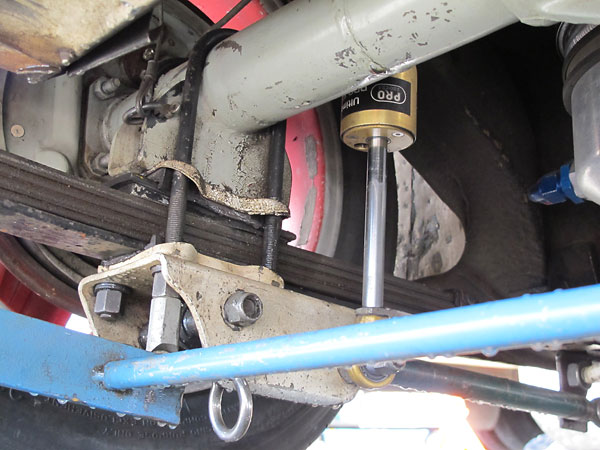
�
Jerry recommends PRO-formance SHOCKS, Inc. shock absorbers. For his front suspension
�
he uses 5" stroke shock absorbers although only ~1.5" of that travel is used.
�
At the rear: 7" shock absorbers and only ~2.5" of the stroke is used.
�
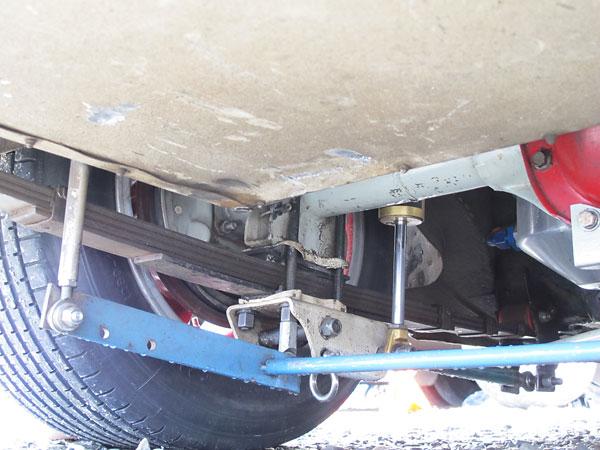
�
This FabTek rear anti-sway bar provides three stiffness settings.
�
Its location makes adjustment very convenient.
�
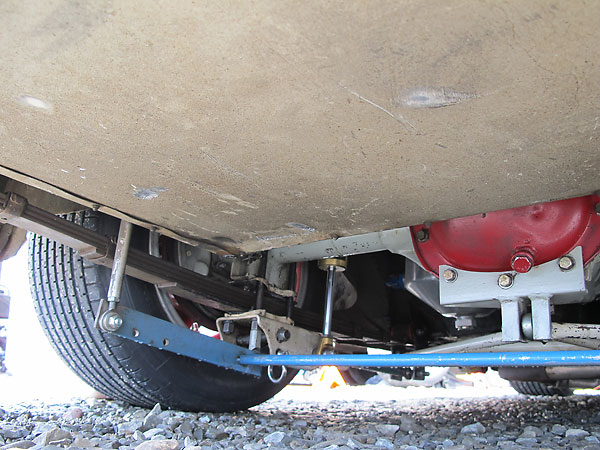
�
Jerry's rear suspension features both traction bars (a.k.a. anti-tramp bars) under the leafsprings
�
and also an A-arm mounted under the differential which keeps the axle centered and moves
�
the rear suspension's roll center to the center of the Heim joint under the differential.
�
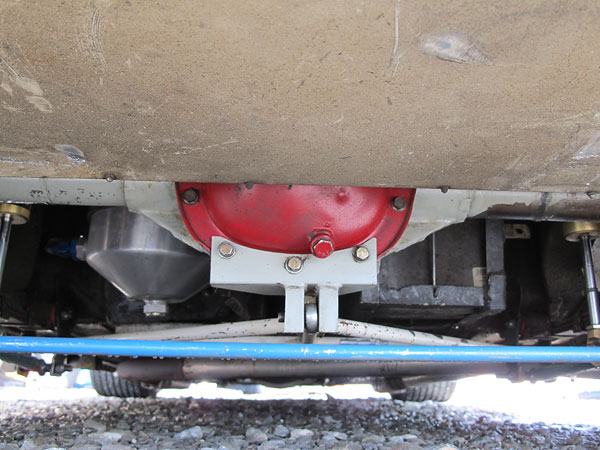
�
Jerry explains: "I've tried a few different ratios. At the moment it's 3.42:1. This is for rolling starts,
�
so I can use 1st gear. The car is OFF like a robber's dog! Nothing gets to the first corner quicker.
�
In 4th on the longest straights, the engine is at peak HP and will do 150+ MPH."
�
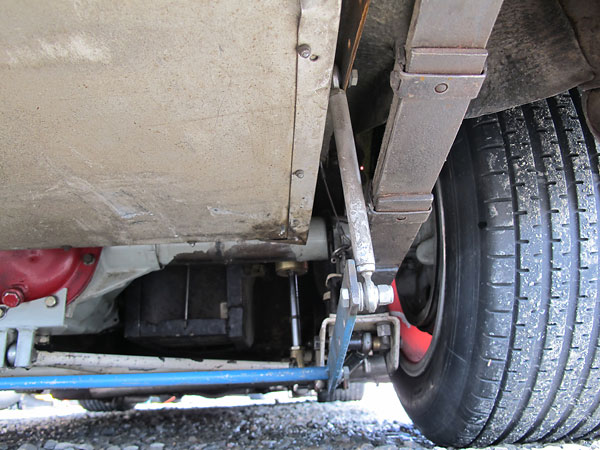
�
"I have developed the brakes and suspension from experience with Saturday night stock car racing.
�
This car is never out-braked into the corners by same class cars - Porsches, etc. - Drivers of
�
lighter cars often remark how deep into corners this MG goes before braking."
�
�
Interior
��
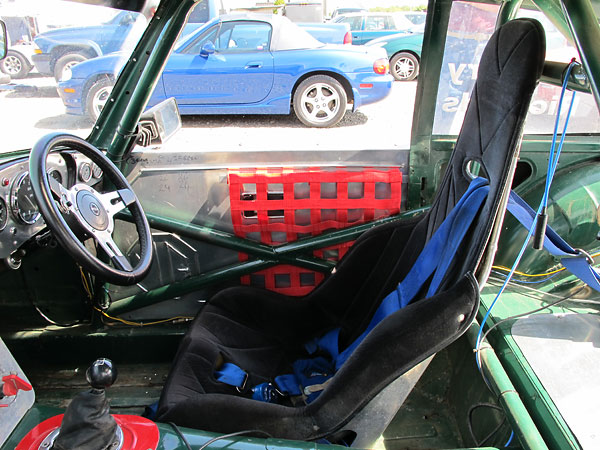
�
Righthand drive is usually a big advantage for road racing because most races run
�
clockwise. Jerry gets a better view of corner apexs and passing opportunities.
�
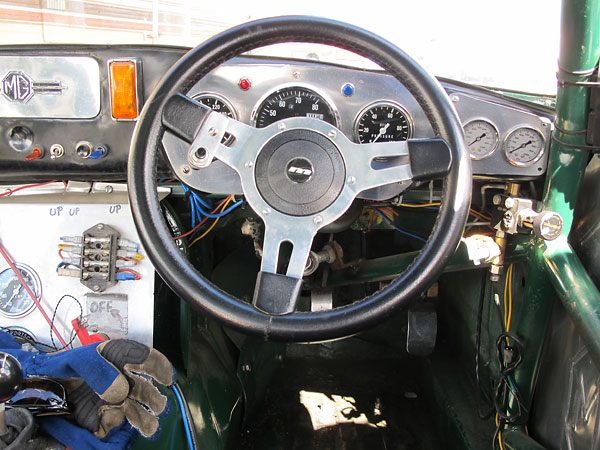
�
Also, because most tracks run clockwise Jerry's cars are set up with side-to-side weight
�
bias (i.e. more weight on the right side tires) and he staggers tire air pressure too.
�
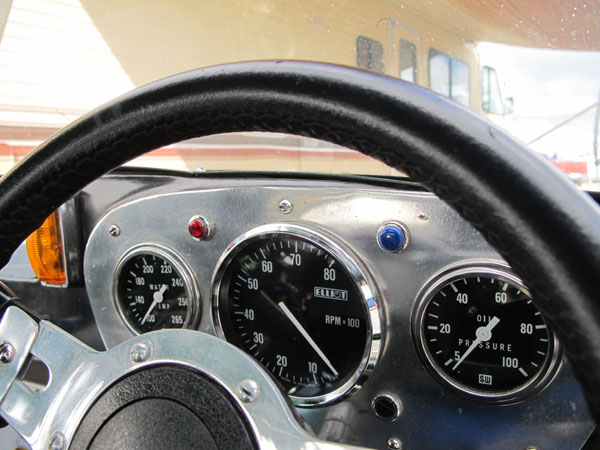
�
Stewart Warner water temperature and oil pressure gauges surround an Elliot tachometer (0-8000rpm).
�
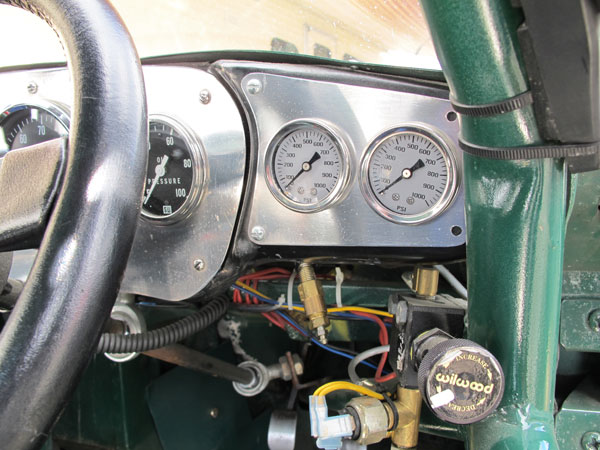
�
Twin mini brake pressure gauges help Jerry dial-in his brake bias. Below, a Wilwood
�
brake proportioning valve facilitates convenient adjustment of the rear circuit.
�
�
Enjoying this article? www.BritishRaceCar.com is partially funded through generous support from readers like you!
�
To contribute to our operating budget, please click here and follow the instructions.
�
(Suggested contribution is twenty bucks per year. Feel free to give more!)�
�
�
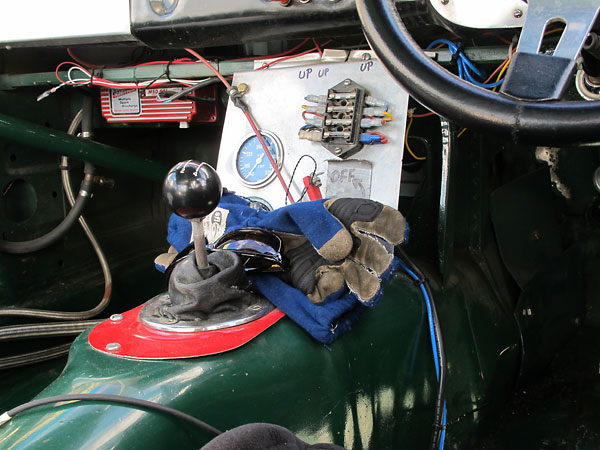
�
Jerry extensively rebuilt the Muncie transmission's Hurst shifter with shortened levers and Heim
�
joints at all the pivots. "The shifts are very positive and really give confidence changing down,
�
which you especially need when you are under heavy breaking from 150 to 30 MPH racing
�
the Porsches at the end of the main straight at Road Atlanta. I love this transmission!"
�
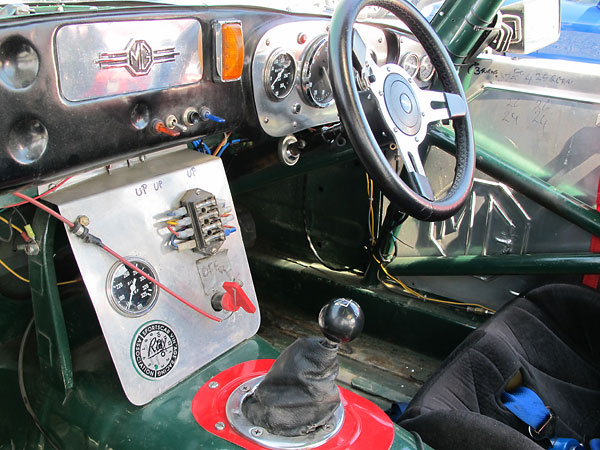
�
The emergency shut-off switch is mounted on the center console, but it can
�
also be remotely actuated via cable from outside the car, on the cowl.
�
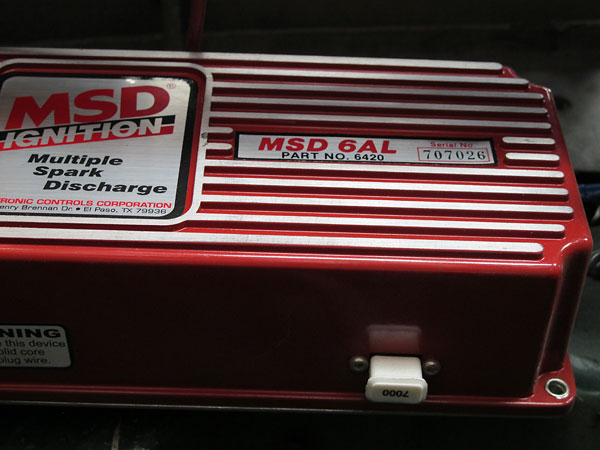
�
MSD Ignition - Multiple Spark Discharge - Model MSD-6AL - Part No. 6420
�
Note that a 7000rpm rev-limiter chip has been selected.
�
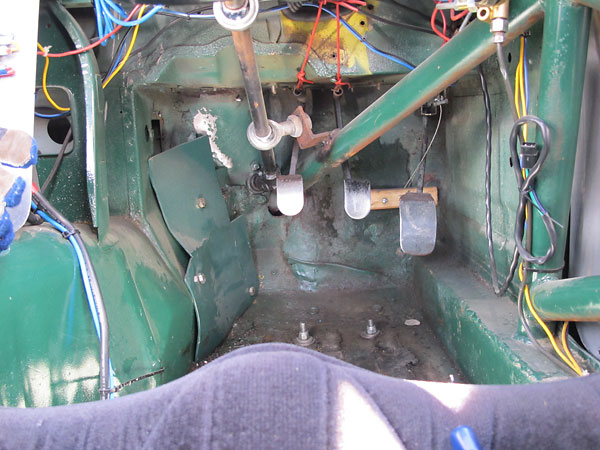
�
Just is case, Jerry has installed a clutch scatter shield to protect the footbox.
�
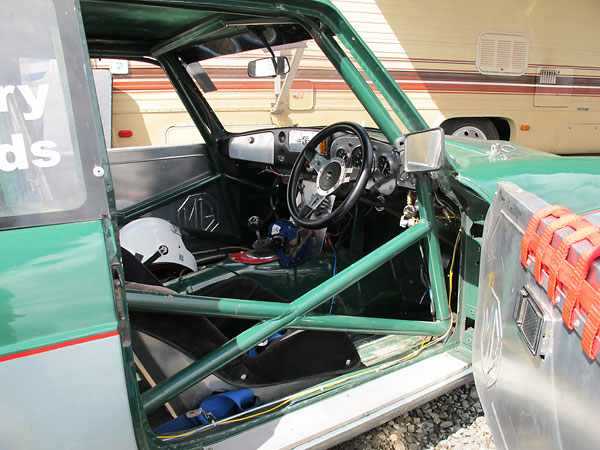
�
Door area cross braces help stiffen the chassis and protect the driver from side impacts.
�
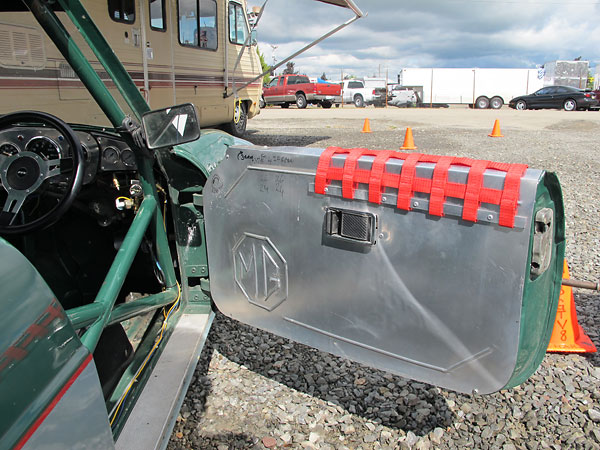
�
Aluminum door panels embossed with MG logos.
�
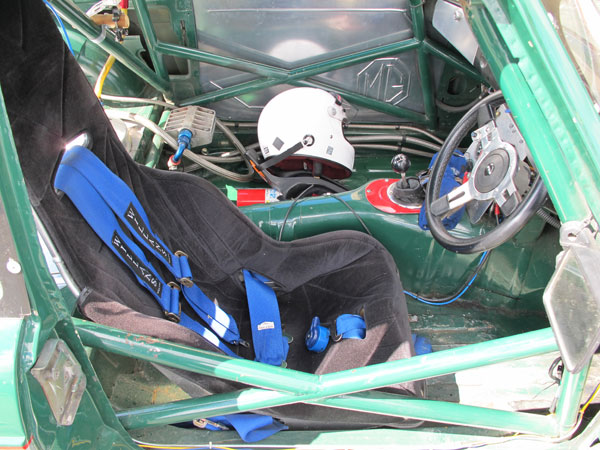
�
Kirkey aluminum racing seat and Willans six point cam-lock safety harness.
�
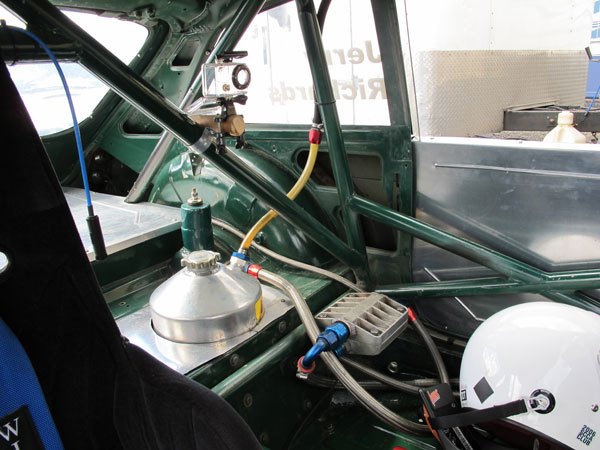
�
Raised turrets have been installed to accommodate telescoping shock absorbers.
�
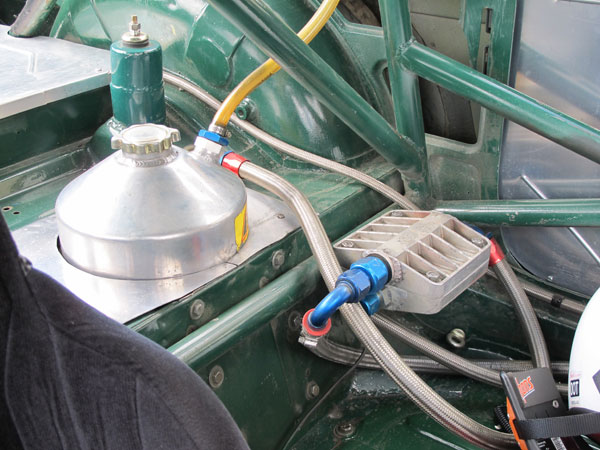
�
Oberg 600 screen type oil filter.
�
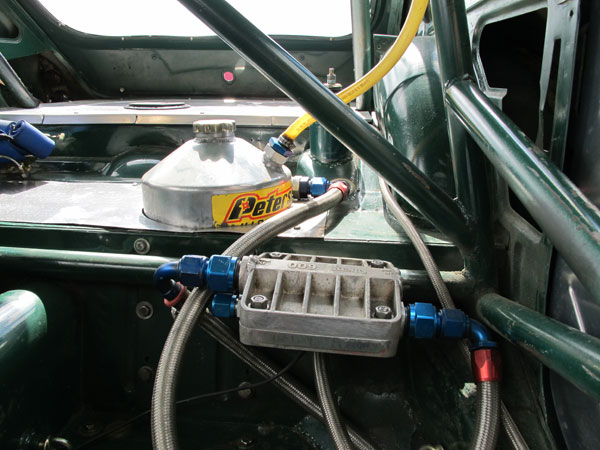
�
Peterson engine oil reservoir.
�
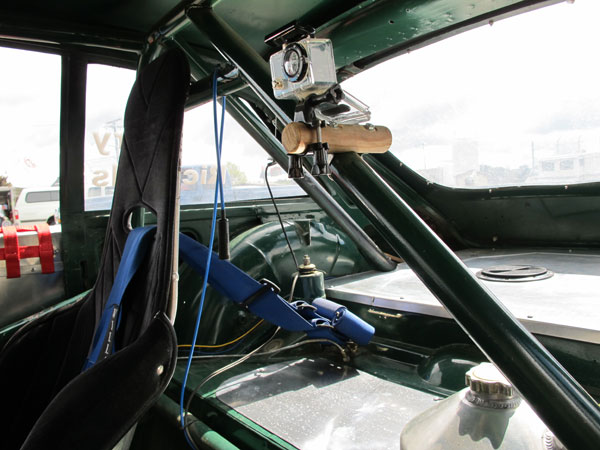
�
This Go Pro HD Hero 2 camera records Jerry's track time so he can review, strategize and improve.
�
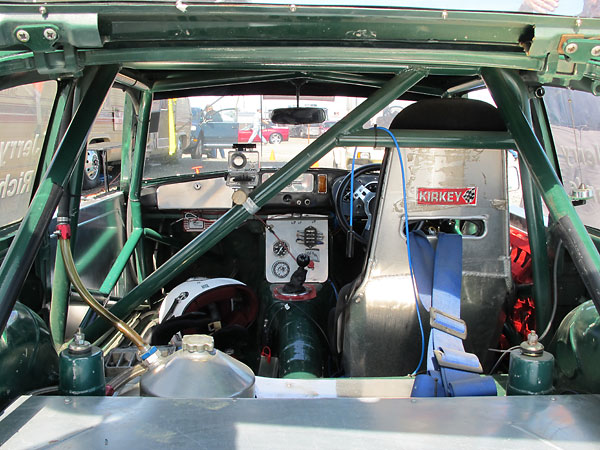
�
Shoulder harness attachment points are rather low. In the event of a high energy
�
impact, the straps may compress the driver's spine. A horizontal bar added
�
to the roll cage at should height would provide a much safer installation.
�
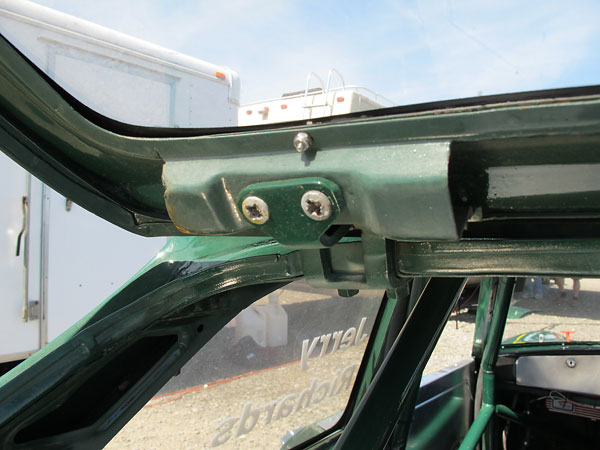
�
The rear hatch's glass has been replaced with polycarbonate and its frame has been lightened too.
�
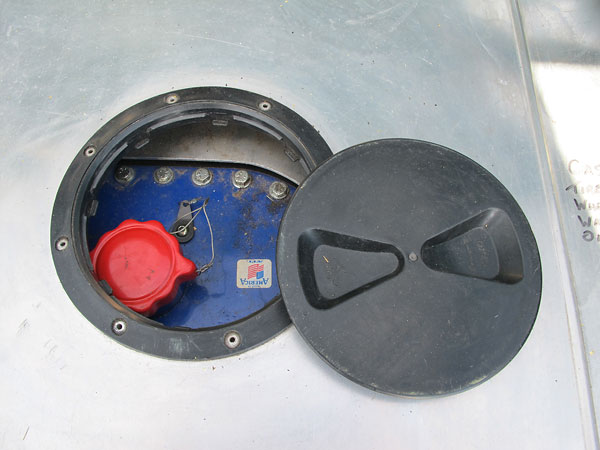
�
ATL twelve gallon aluminum cannister fuel cell, under a thin aluminum cover.
�
�
Exterior
��
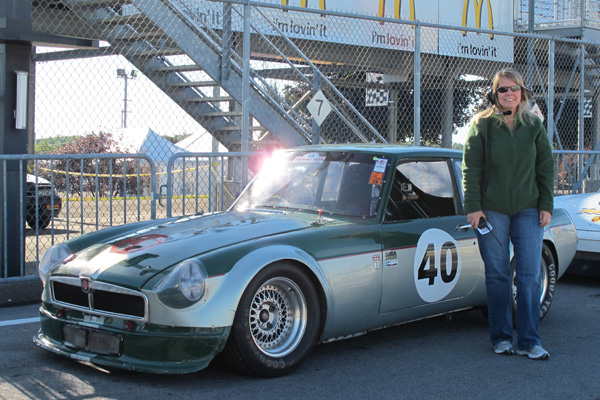
�
Crew Chief Mary
�
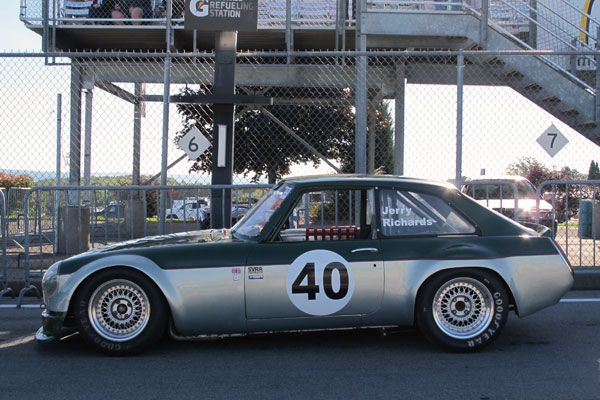
�
In this photo, Jerry's MGB GT V8 is shown queued up for the Saturday morning qualifying session
�
of SVRA's 2010 U.S. Vintage Grand Prix at Watkins Glen. Jerry qualified third quickest of fifty
�
Group 8 racers. He achieved an average speed of 91.219 mph around the grueling 3.4 mile circuit.
�
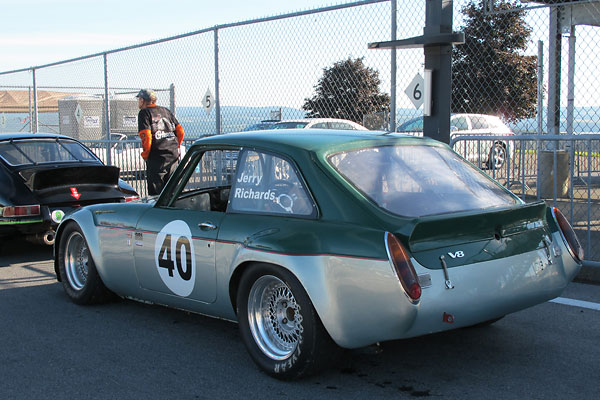
�
After qualifying, Jerry's parked MGB GT V8 was struck by a Lotus Seven. (We understand the
�
Seven's rear axle broke, causing its driver to lose control.) Jerry wasn't even in his car at the time!
�
However, due to damages incurred, Jerry was unable to continue racing his MGB GT that weekend.
�
After returning home, Jerry was able to quickly bring his racecar back to good-as-new condition.
�
�
Enjoying this article? www.BritishRaceCar.com is partially funded through generous support from readers like you!
�
To contribute to our operating budget, please click here and follow the instructions.
�
(Suggested contribution is twenty bucks per year. Feel free to give more!)�
�
�
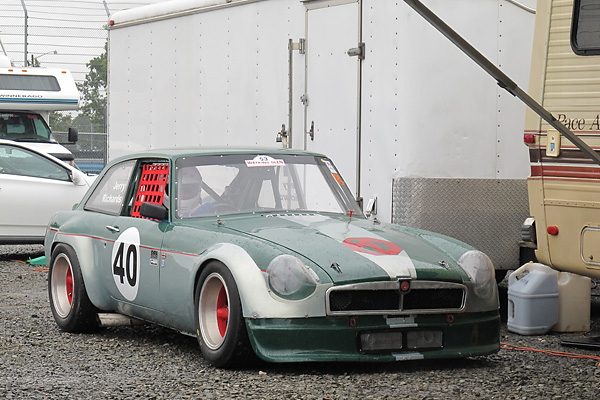
�
Jerry fabricated the fiberglass fenders for this racecar. Styling was obviously based on the iconic MGC
�
"GTS" design developed for the MG works team's entries in Sebring twelve hour endurance races.
�
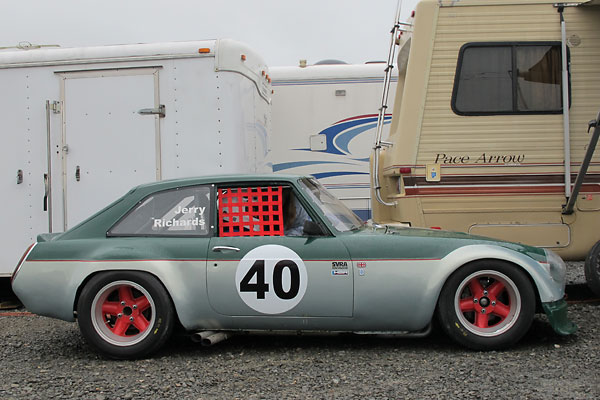
�
Earlier in the weekend, for a practice session with damp track conditions, Jerry had switched
�
over to Michelin PB49 rally tires mounted on classic Revolution five-spoke aluminum wheels.
�
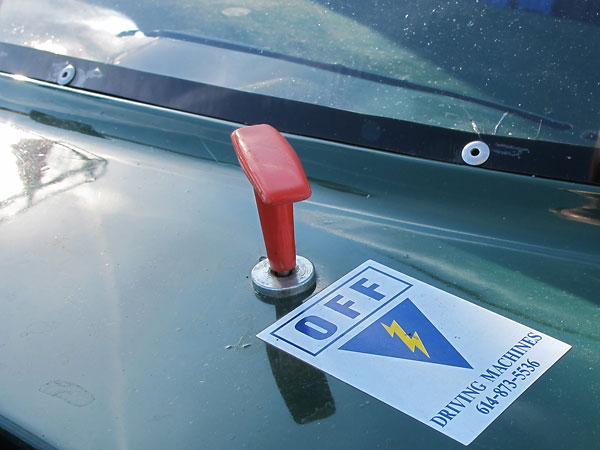
�
Cable remote for the engine "kill" switch. (Sticker says: Driving Machines 614-873-5536)
�
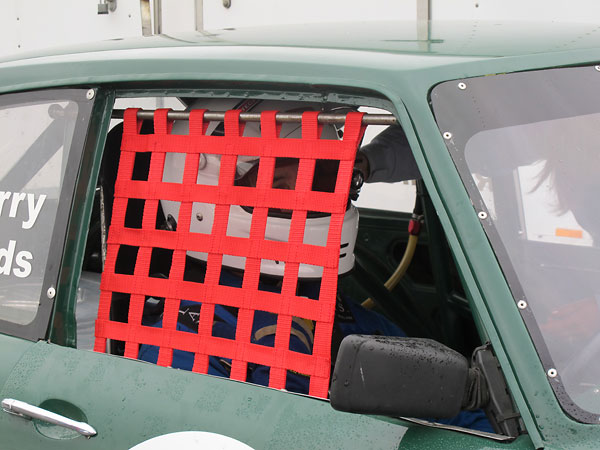
�
Window nets keep a driver's arms within the car in the event of a rollover.
�
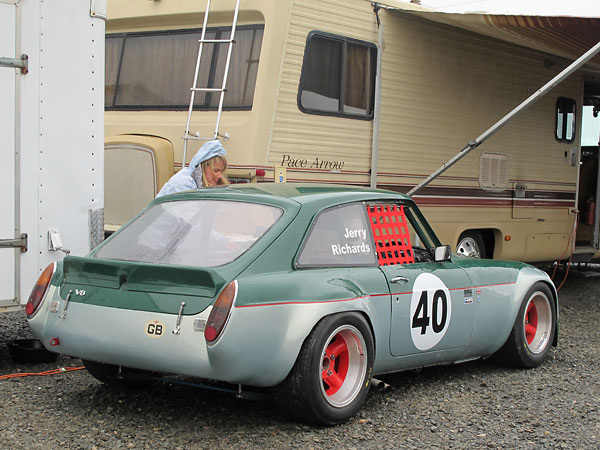
�
Weather is typically quite variable at Watkins Glen in the second week of September.
�
This day: rainy and windy in the morning, then blues skies and sunshine all afternoon.
�
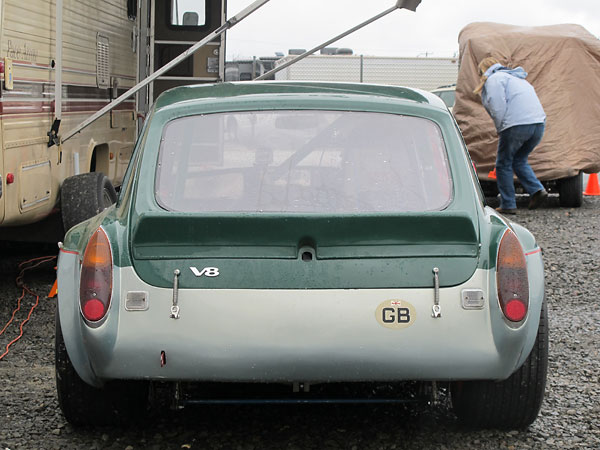
�
MGB GT fiberglass rear hatch spoiler from Targett Motorsport.
�
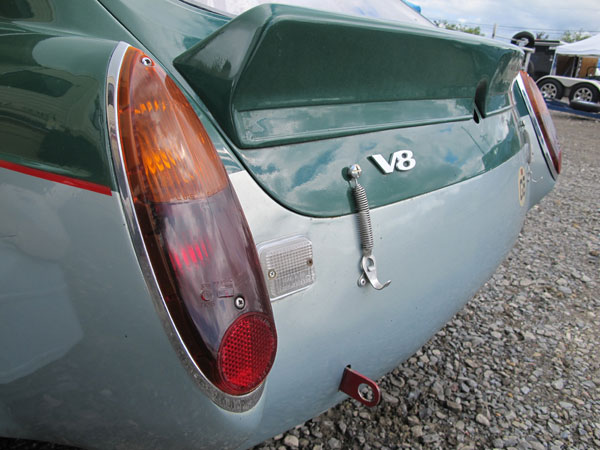
�
London taxi taillamps.
�
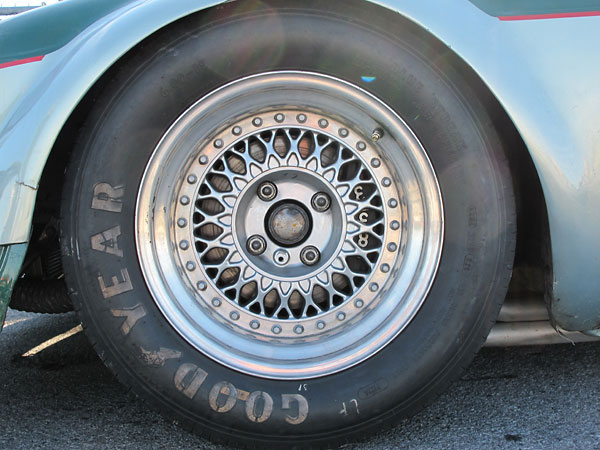
�
Compomotive 3-piece aluminum wheels (15x7.5).
�
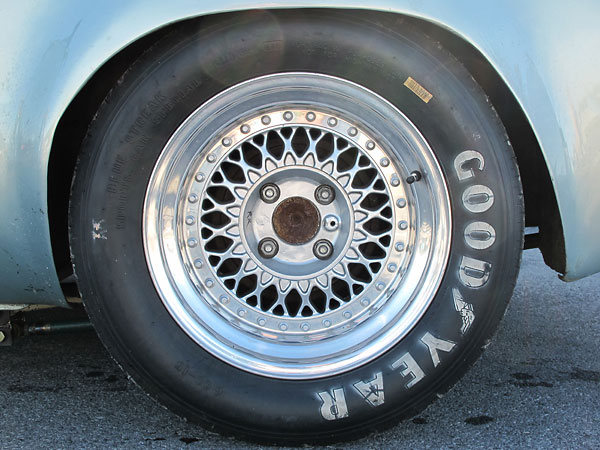
�
Goodyear Blue Streak tires (6.00x15).
�
�
All photos shown here are from September 2010 when we viewed the car at Glenora Winery's Vintage Grand Prix�
of Watkins Glen, New York. Photos by Curtis Jacobson for BritishRaceCar.com, copyright 2012. All rights reserved.
�
| Notes: | ||
| (1) | �
Some features and specifications of the car have changed since we photographed it.�
Specifically, a Rover 3.5L engine has been installed in lieu of the Buick 215�
engine shown. (Rover 3.5L and Buick 215cid engine blocks are nearly identical in�
every dimension, although casting techniques were quite different.) Wilwood�
master cylinders have replaced the Tilton master cylinders shown above. � | |
�
| �
� 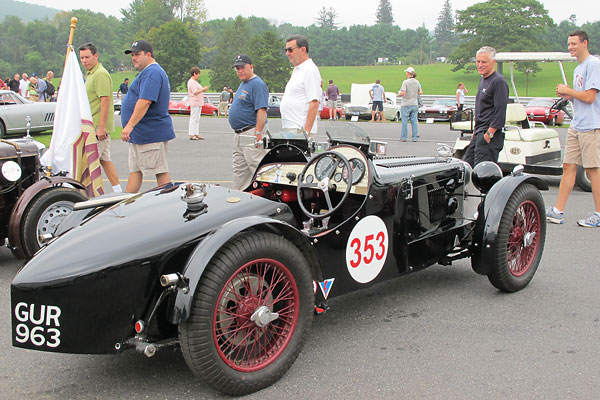 � Harry Lester's MG P-type (GUR 963), as photographed by Curtis Jacobson for BritishRacecar.com � Did you enjoy this article? Do you value the unique information our website delivers? � Please help us grow and thrive! Your donation will help us publish more articles. � � � Special edition BritishRacecar.com stickers will be sent to all contributors! � All supporters are publically recognized in our V.I.P. Contributors list, here.� |
�
| If you liked this article, you'll probably also enjoy these: | �|||||
 | �
Les Gonda 1973 MGB GT V8 | �
 | �
Keith Burnett 1972 MGB GT V8 | �
 | �
Storm Field 1972 MGB GT V8 | �
| You're invited to discuss anything you've seen here on The British Racecar Motorsports Forum! | �|||||
�
Notice: all the articles and almost all the photos on BritishRacecar.com are by Curtis Jacobson.
�
(Photos that aren't by Curtis are explicitly credited.) Reproduction without prior written permission is prohibited.
�
Contact us to purchase images or reproduction permission. Higher resolution images are optionally available.
�

 �
�